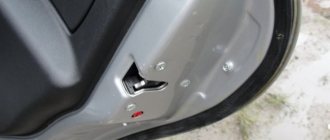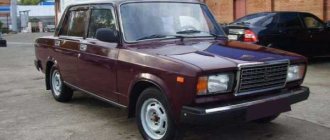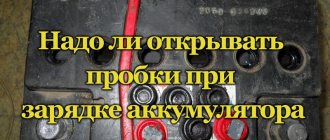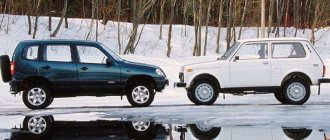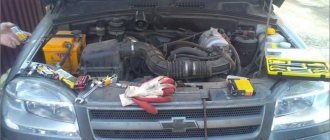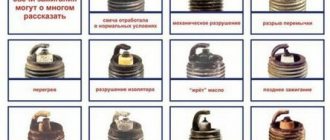Calculation results
Cost of installing gas equipment: Annual savings: Payback period: This is an investment of money at % per annum
a) Consumption coefficient of propane-butane (l) compared to gasoline (l) = 1.15; those. if gasoline consumption is 15 l/100 km, then propane consumption will be 17.25 l/100 km.
b) Methane consumption coefficient compared to gasoline = 0.9; those. with a gasoline consumption of 15 l/100 km, methane consumption will be 13.5 m3/100 km.
c) The volume of methane is measured not in liters, but in cubic meters. A 100 liter cylinder holds 25 m 3 of methane (100 l / 4 = 25 m 3).
We drove the first bi-fuel Lada 4×4 CNG.
LADA > 4×4
If everyone has gotten used to Vesta CNG, which we talked about last year (ZR, No. 8, 2017), then a racing SUV running on compressed gas is out of the ordinary. So far, the Lada 4×4 CNG built in 2021 (the brainchild of the ATC group of companies) exists in a single copy, but the gas equipment installed on it is completely “civilian”, like Vesta’s.
How to remake a towbar and muffler.
Installing LPG on a Chevrolet Niva will invariably require changes to these devices. The most successful solution would be to use a tow bar from Bertone. It should then be modified so that:
- A pipe with a diameter of 34 mm is prepared and bent around the circumference of the cylinder.
- The mounting plate is moved and cut off. After which the additional bracket is removed so that in the future it does not interfere with the filling neck for maintenance.
Remaking the muffler consists of installing a system with two modules, one of which will have a bend in order to bypass the cylinder.
But before you independently install LPG on a Chevrolet Niva, you should remember that this is a rather dangerous procedure, the violation of technological processes of which can lead to unpredictable consequences.
In conclusion, it is worth noting that it is better to carry out the work at a service station in order to fully comply with the technological process and be able to check the functionality of the system using special equipment.
How is it made?
Since rear seats are not needed in a racing car, the stock petrol tank was kept in its original form: the standard 42 liters are used as reserve fuel storage. And immediately behind the “cross” of the safety cage, behind the backs of the crew, there is the main tank - a metal-composite cylinder with compressed methane.
The cylinder of the Chinese company Sinoma, like that of Vesta, holds 90 liters (or 21 cubic meters) of compressed methane, and this is enough for 250–270 km in racing mode. The length of stages in Russian rally-raids is approximately the same, so almost the entire distance of a racing day is covered on gas, and about 10% of fuel costs are on gasoline.
The crew includes pilot Alexander Orlov and navigator Petr Ponomarev, who have a special permit to drive a dual-fuel racing car. The crew must have the skills to quickly eliminate or at least reduce the consequences of possible gas problems.
As Alexander Orlov told us, in his racing career he had experience driving a car running on a propane-butane mixture. The transition to methane is due to the fact that the gasoline consumption of such a car is 15–20% less, and safety is higher (methane has a fourth class of danger).
Features of installation of gas equipment
There is no space in the trunk of the Chevrolet Niva for a spare wheel. Therefore, this machine does not use a toroidal balloon. Only cylindrical gas containers are installed.
The following options for cylinder placement are available:
- In the trunk (longitudinal and transverse).
- Under the luggage compartment (under the bottom).
The second option preserves the volume and is more preferable, since it does not reduce the volume of the trunk. However, to do this you will have to redesign the towbar and muffler. Otherwise, these parts will interfere with the installation of the cylinder.
The modification of the muffler consists of installing an additional curved pipe, the bend of which passes under the cylinder.
In the towbar, you need to remove one mounting plate that interferes with the cylinder, and an additional bracket that rests on the filling neck.
Instead of remaking the old one, you can buy a new tow hitch, the design of which involves installing a cylinder under the car.
What are the progress?
At the beginning of the 2021 season, this Lada 4x4 was brand new and was equipped with a standard LPG. But the working conditions cannot be called standard - on the contrary, they were extreme. So at each stage of the rally raid, in addition to regular mechanics, specialists worked with the car to monitor the engine power system. At first there was a lot of work, but there were no emergency situations, and the loss of engine power using methane compared to its gasoline counterpart was minimized over time.
Gradually, the car “rolled out” quite well, allowing the crew to achieve high results in the Russian rally-raid championship. The result of the season was second place at the Crimea Baja, second place at the Great Steppe-Don rally raid, third place at the Russian Hills and victory at the MRC Baja.
By the end of the season, the dual-fuel Niva had accumulated about 20 thousand combat kilometers. Due to the fact that this is not a cramp or an extreme prototype, but a fairly “resourceful” racing car, prepared according to the requirements of the most democratic class N (included in the T2 rally raid classification for cars with minimal modifications), such a mileage is not considered large. Last winter, the car went through a rebuild - a complete overhaul with repairs and replacement of everything necessary - and went to the first start of the 2018 season radically updated.
How's it going?
We waylaid the methane Niva before the start of its second racing season. Class N technical regulations imply only minimal preparation of the car: a safety cage is required, some modifications to the body and exhaust system are allowed, recalibration of the engine ECU, suspension tuning, replacement of shock absorbers and brake pads. The pilot's seat, seat belts are all standard. In general, the Niva remained the Niva, including the interior - only the petrol/gas switching indicator appeared.
Instead of each standard shock absorber, two Kayaba Ultra SR gas monotubes are installed (shock absorbers with a remote reservoir are prohibited by technical regulations), the rear axle and side members have impressive reinforcement.
The engine starts immediately on methane (this is also a requirement of the regulations), roars with a racing exhaust and fills the cabin with a guttural grumble. The acceleration dynamics, however, are completely normal for the Niva, that is, unremarkable. But any significant lag from the purely gasoline version is not felt.
For what?
Why fence a garden? Why do we need to recalibrate the engine for methane, all this painstaking fine-tuning and “finishing” a car with a non-standard power system in racing conditions? After all, a gasoline Niva would drive at least no worse.
For the ATC group, racing technology is a completely new direction. Having started several years ago with the conversion of cars for propane-butane mixtures, she became a partner of AVTOVAZ on the Vesta CNG and Largus CNG projects. And since methane cars have stereotypes about unreliability and unsafety (and even less power), they made an attempt to refute them through participation in racing.
Interest in competitions, in principle, increases if vehicles with bi-fuel engines participate in them - they are still perceived as a curiosity (remember the gas trucks of Andrei Karginov and Sergei Kupriyanov from the KAMAZ-Master team). Even the RAF has not yet developed a clear approach to allowing such vehicles to compete. But in addition to the advertising “exhaust”, there is also a purely engineering one: successful solutions born in racing (ECU calibration, for example) are transferred to the “civil sector” - to work with the same Vesta and Largus.
It is likely that the story with the methane Niva will grow into something larger - for example, into the creation of Russia’s first national gas engine championship, which will be held in several motorsports disciplines, from rally raids to circuit racing.
Oh, if all this would somehow help get rid of the main stereotype associated with methane cars - the belief that it is almost impossible to refuel them anywhere outside the ring roads of the two capitals. No matter how much you take care of your wallet or care for the environment, filling a cylinder with compressed gas is much easier in a race than in real life.
Based on the gasoline consumption data for 4 trim levels of 2121 Niva (4x4), we calculate gas consumption. Let's calculate how much cheaper gas filling is. How many kilometers will a 2121 Niva travel without refueling?
Operating principle of HBO
According to the design and technical characteristics, gas equipment is divided into several generations:
- 1st generation. It is a vacuum reducer with gas supply to the mixer by opening the intake manifold with vacuum;
- 2nd generation. The so-called electronic gearbox, in which the fuel supply is controlled by an electromagnetic valve that is activated upon ignition.
- 3rd generation. Electronic gearbox with feedback in the form of a lambda probe control system. The operation of such a gearbox is associated with a negative effect - reverse clap, which indicates a constant risk of equipment breakdown.
- 4th generation. This system provides controlled fuel supply through electromagnetic injectors.
Cylinder for gas equipment 4th generation
Among devices operating on injectors, the Gromyko Gas Injector (GIG) is considered to be the most suitable for working in the field. This system from Russian manufacturers is distinguished by the presence of one gas nozzle. Among the HBO sets in this series, GIG 3 and GIG 3 DL are optimal for use in the field. Regulation, startup and shutdown of the system is carried out using specialized software. The advantage of GIG 3 DL, among other things, is that there is no need to install additional emulators. For new car models like Lada Largus, you can choose an acceptable option among imported analogues.
When choosing equipment for the field, it is worth considering that injection cars are far ahead of carburetor cars in many respects. On Niva cars this advantage is especially clearly visible.
Niva owners should opt for GIG 3 DL
Among the wide range of gas equipment, Niva owners should choose the GIG 3 DL or purchase an imported electronic ejector system.
DON'T WASTE MONEY ON REPAINTING! Now you can remove any scratch from the body of your car in just 5 seconds.
As experience shows, reworking with a gas generator in the field after adjustment pays for itself quite quickly, compared to spending on refueling with gasoline. The ejector system does not have such advantages, but it can be found on models 21213 and 21214, for example, the Lovato system.
Costs of 2121 Niva on gasoline
Gasoline costs
| Volume | Transfers | Gasoline type | Gasoline consumption by road type | Price of 1000 km of gasoline, mixed mode | ||
| In the city | On the road | Mixed | ||||
| 1.6 | Mechanics | 92 | 13.0 | 7.0 | 9.0 | |
| 1.6 | Mechanics | 95 | 13.0 | 7.0 | 9.0 | |
| 1.7 | Mechanics | 95 | 11.0 | 8.0 | 9.0 | |
| 1.7 | Mechanics | 92 | 11.0 | 8.0 | 9.5 | |
| Consumption in liters per 100 km. Gasoline price in rubles per liter: 92 - 34.30 rubles, 95 - 37.42 rubles. | ||||||
Is it worth installing gas equipment on Niva?
Adequate gasoline consumption in modern passenger cars for everyday use has long varied between 6-8 liters per hundred kilometers. Of course, under normal operating conditions. In current realities, if the figure exceeds ten, for many this line is a reason to re-equip vehicles to run on alternative fuels.
With an engine capacity of 1.7/1.8 liters, the Chevrolet Niva rarely manages to keep gas consumption within 10 liters. Considering that these vehicles are often used on rough terrain, and with permanent all-wheel drive and a trailer, fuel consumption reaches 12-15 liters.
Therefore, the question of installing gas equipment on Shniva is obvious. Owner reviews prove that gas consumption on a Chevrolet Niva with 4th generation LPG, subject to proper installation and correct settings, rarely exceeds 14 liters. Typically the indicators are:
- city 13-14 liters
- highway up to 90 km/h – 10-11l., over 110 km/h – 13l
- mixed cycle 11-13l
Of course, operating conditions (winter, trailer, dirt, etc.), as well as driving style, affect the values, however, the cost of gasoline versus propane-butane and methane is not yet comparable.
It is worth noting that the issue of payback for gas equipment is individual. It all depends on the mileage, the price of fuel and the cost of the gas system. You can calculate when HBO will pay off on our website by following this link.
Costs of 2121 Niva on gas, difference
Propane consumption, savings
| Volume | Transfers | Gas type | Gas consumption by road type | Refueling for 1000 km, mixed mode | ||||
| In the city | On the road | Mixed | Petrol | Gas | Difference | |||
| 1.6 | Mechanics | CIS | 14.3 | 7.7 | 9.9 | 3 087 ₽ | 1 842 ₽ | |
| 1.6 | Mechanics | CIS | 14.3 | 7.7 | 9.9 | 3 368 ₽ | 1 842 ₽ | |
| 1.7 | Mechanics | CIS | 12.1 | 8.8 | 9.9 | 3 368 ₽ | 1 842 ₽ | |
| 1.7 | Mechanics | CIS | 12.1 | 8.8 | 10.5 | 3 259 ₽ | 1 954 ₽ | |
| LPG - liquefied petroleum gas (propane). Gas price in rubles per liter: CIS - 18.61 rubles. | ||||||||
Compressed natural gas is consumed in city mode at the speed of gasoline, and on the highway it is 20% slower. CNG is cheaper than LPG by one and a half to two rubles per liter.
Examples of savings in Moscow
For example, let's calculate two distances:
- From Red Square to the Moscow Ring Road and back in Moscow 50 km. How much gas does one save per month of such trips?
- From Moscow to Sochi - 1600 km. How much cheaper will it be to fill up with gas?
Savings after installing HBO
| Volume | Transfers | From Red Square to the Moscow Ring Road and back × month | From Moscow to Sochi and back | ||||
| Petrol | Gas | Saving | Petrol | Gas | Saving | ||
| 1.6 | Mechanics | 4 631 ₽ | 2 764 ₽ | 1 867 ₽ | 9 878 ₽ | 5 896 ₽ | 3 983 ₽ |
| 1.6 | Mechanics | 5 052 ₽ | 2 764 ₽ | 2 288 ₽ | 10 777 ₽ | 5 896 ₽ | 4 881 ₽ |
| 1.7 | Mechanics | 5 052 ₽ | 2 764 ₽ | 2 288 ₽ | 10 777 ₽ | 5 896 ₽ | 4 881 ₽ |
| 1.7 | Mechanics | 4 888 ₽ | 2 917 ₽ | 1 971 ₽ | 10 427 ₽ | 6 223 ₽ | 4 204 ₽ |
| Prices for a liter of gasoline and gas: 92 - 34.30 ₽, 95 - 37.42 ₽, CIS - 18.61 ₽. | |||||||
Mileage without refueling before installing LPG
Let's look at the size of the VAZ 2121 Niva fuel tank (4x4) for gasoline and the most common size of the installed gas cylinder.
Tank VAZA 2121 Niva (4x4), autonomous mileage
| Volume | Transfers | Tank capacity | Refilling the tank | Autonomous mileage on a full gas tank | ||
| In the city | On the road | Mixed | ||||
| 1.6 | Mechanics | 42 l. | ||||
| 1.6 | Mechanics | 42 l. | ||||
| 1.7 | Mechanics | 42 l. | ||||
| 1.7 | Mechanics | 42 l. | ||||
| Gas tank capacity in liters. Gasoline price in rubles per liter: 92 - 34.30 rubles, 95 - 37.42 rubles. | ||||||
Autonomous mileage after switching to gas
Autonomous mileage 2121 Niva (4x4) with gas equipment
| Volume | Transfers | Cylinder capacity | Refilling the cylinder | Total autonomous mileage | ||
| Around town | On the road | Mixed | ||||
| 1.6 | Mechanics | 47 l. | ||||
| 1.6 | Mechanics | 47 l. | ||||
| 1.7 | Mechanics | 47 l. | ||||
| 1.7 | Mechanics | 47 l. | ||||
| Price per liter of gas in calculations: CIS - 18.61 ₽. | ||||||
HBO increases the autonomous mileage of the VAZ 2121 Niva 1977...present SUV. doubled. Now there is definitely enough fuel for the longest trips.
Call to ask questions, consult with a specialist or sign up for installation in Moscow (24 hours a day) or write to [email protected]
Certified multi-brand center for installation, maintenance and repair of gas equipment:
Gas Performance Benefits
IN COMBINATION, THESE FACTORS EXTEND THE ENGINE LIFE BY
Gas extends the life of oil and spark plugs and reduces vehicle maintenance costs.
Gas burns a little slower than gasoline, which reduces the load on the piston group and crankshaft, causing the engine to run smoother.
The gas mixes easily with air and fills the cylinders more evenly with a homogeneous mixture, so the engine runs smoother and quieter. The gas mixture burns almost completely, so no carbon deposits form in the pistons, valves and spark plugs.
The octane number of petroleum gas is 103-105, which virtually eliminates detonation of engine parts. This advantage of gas can be especially important for engines with a high compression ratio that consume high-octane (and therefore expensive) gasoline.
The gas does not contain harmful impurities (lead, sulfur), which at the chemical level destroy the combustion chamber parts, catalytic converter and lambda probe.
The gas enters the engine in the vapor phase, so it does not wash away the oil film from the walls and does not dilute the oil in the crankcase.
Savings on fuel are greater than the overpayment on the loan
First payment 0 rub.
Loan term from 1 month
Loan cost 1.6% per month
Loan decision in 15 minutes
Switch to gas and start saving
You will get back the overpaid money for using a two-year loan in the second month of operating the system.
On average, the savings per year when driving on gas is 50,000 rubles.
Save up to 200,000 rubles per year
1 km of mileage on gas is 2 times cheaper than 1 km of mileage on gasoline
Calculate the savings of driving on gas compared to using gasoline
1. Select your car
For example: Peugeot Partner, Citroen Berlingo, Renault Kangoo, VW Caddy
2. Indicate the mileage of your car per year
Having extensive experience in operating gas equipment (already the 4th car on gas!), I can confidently say that AGTS specialists are the best professionals in converting cars to gas in St. Petersburg. no less than 100 percent. The feeling is super, if you have any doubts, I highly recommend it.
This is the second time I've come here. Hyundai Accent is my second car and, accordingly, my second LPG. Just like the first time, I installed Italian equipment from Lovato. It seems to me that it is the best. At least it’s very easy to set up, which can’t be said about other systems. And stability in operation: the settings are the same as they are. In total, I have been using HBO for 4 years now, and no problems. The most important thing is to regularly visit maintenance and immediately correct errors if something is wrong.
For me, LPG is no longer new - I’ve been driving gas for almost 10 years, and I install it on every new car. I think it’s not worth describing all the delights of the equipment, and a lot of things have already been told without me. I’ll tell you better how the installation of gas equipment in the AGTS went. I made an appointment with the guys a week in advance, arrived at the appointed time, and they were already waiting for me. The box is large and well equipped. Two people are allocated for each car, everything is done quickly and smoothly. I stood there, watching them. It is immediately clear that the team has worked well together. One installs the wiring, the other connects the cylinder. It’s obvious that they know their job here: every car is there – and on the day I arrived, it was sold out. Everyone is busy, there is no unnecessary talk, just business. At this rate, they installed the HBO for me for about two hours, probably, then one worker explained how it works, what is connected to what, etc. That is, in addition to the fact that they quickly installed it, they also gave instructions on how to use it and what to do if something goes wrong. This, it seems to me, is just great for those who are encountering HBO for the first time. And I, an experienced gas driver, was pleased to listen) In general, I recommend it!
Which 4th generation HBO is better to install on a Chevrolet Niva
Since the 2nd generation gas equipment is installed mainly on carburetor cars, and the methane system is more expensive, the optimal solution for the Chevy Niva is the fourth generation of propane gas equipment.
When selecting a gas system, in addition to price, you should pay attention to the following factors:
- brand awareness and time on the market
- availability of equipment warranty
- maintainability
- provision of documentation for gas equipment registration, as well as car warranty service
- presence of certified service centers of the manufacturer in your locality
As a rule, recognized companies such as Digitronic, Lovato, OMVL, Tamona, Atiker, Torelli, Zenit, BRS, Prince already have in their line ready-made solutions and equipment for a specific car, both more expensive and cheaper. By the way, the last two representatives are from the premium segment.
For example, a digital system with a maxi-2 controller will cost 29-30 thousand rubles, the BRC Sequent model also works great, but the price is already 40-42 thousand rubles. (GBO + installation without modifications).
You can also choose an LPG yourself; the installation kit consists of:
- balloon
- Europe class multi-valve
- gas level sensor (optional)
- external filling device
- lines (consumable/refueling)
- gas hose
- gearbox
- solenoid valve
- fine filter
- map sensor
- nozzles with inserts
- gas and reducer temperature sensor
- Control block
- gas/petrol switch
- buzzer
- wiring kit
- variator UOZ (optional)
- mounting elements (clamps, tees, couplers)
The main thing to remember is that the performance of the evaporator reducer is selected based on the power of the machine’s power unit.
Read more about choosing a 4th generation HBO here.
